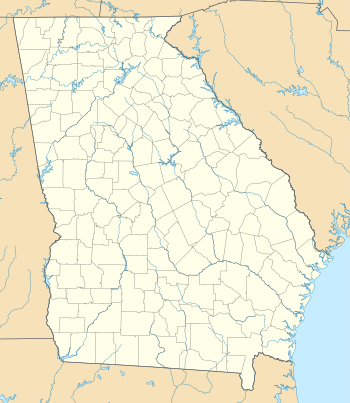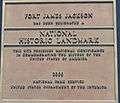Fort James Jackson
|
Old Fort Jackson | |
|
Moat at Fort Jackson | |
  | |
| Location | Islands Expwy., Chatham County, near Savannah, Georgia |
|---|---|
| Coordinates | 32°4′55″N 81°2′10″W / 32.08194°N 81.03611°WCoordinates: 32°4′55″N 81°2′10″W / 32.08194°N 81.03611°W |
| Built | 1808 |
| Architect | William McRee |
| NRHP Reference # | 70000200 |
| Significant dates | |
| Added to NRHP | February 18, 1970[1] |
| Designated NHL | February 16, 2000[2] |
Fort James Jackson (usually called Old Fort Jackson or shortened to Fort Jackson) is a restored 19th-century fort located on the Savannah River, two miles east of the city of Savannah in the U.S. state of Georgia. It is a National Historic Landmark and the oldest standing brick fort in Georgia.[3]
U.S. President Thomas Jefferson authorized the construction of a national defense system of fortifications to defend his new nation. Jefferson's system included Fort Jackson, constructed between 1808 and 1812 over an old earthen battery from the American Revolution. At the time, war with Great Britain or France seemed likely, and Fort Jackson was the best site from which to protect Savannah from attack by sea. In the War of 1812, local militias and U.S. troops saw active duty at Fort Jackson. After the War of 1812, two periods of construction followed at the fort. A moat, drawbridge, brick barracks, privies, a rear wall, and another powder magazine were added.[3]
James Jackson, the namesake of the fort, was a British native who fought for the American cause and rose to the rank of colonel. When he was twenty-five, Jackson accepted the surrender of the British in Savannah at the close of the revolution. He was later a U.S. Representative, U.S. Senator, and Governor of Georgia. He is interred at the Congressional Cemetery in Washington, D.C..[3]
During the American Civil War, Fort Jackson, along with nearby Fort McAllister and Fort Pulaski, defended Savannah from Union attack. In 1862, Fort Jackson was shelled from a ship captained by an escaped slave named Robert Smalls. The fort was commanded by Colonel Edward Clifford Anderson and would become the Confederate Headquarters for the Savannah River defenses, including the Confederate Navy.
When the Union Army commanded by William T. Sherman captured Savannah by land on December 20, 1864, Confederate troops abandoned the fort and retreated across the Savannah River into South Carolina. Confederate troops from Savannah joined other forces in North Carolina and South Carolina and continued to fight until April 26, 1865, when they surrendered to General Sherman's army at Durham, North Carolina. Several different regiments garrisoned Fort Jackson during the Union occupation of Savannah. One of these units was the 55th Massachusetts Regiment, which consisted of African American troops.[3]
From 1884 to 1905, Fort Jackson was known as Fort Oglethorpe and was little used by the U.S. military. It was purchased by the city of Savannah in 1924 for park purposes but not fully restored until the 1970s.[2][4]
Fort Jackson is located at 1 Fort Jackson Road,[4] on the Islands Expressway linking Savannah to Fort Pulaski and the town of Tybee Island.[2]
Fort Jackson is owned by the state of Georgia and operated as a museum by Coastal Heritage Society, which also manages Savannah History Museum, Georgia State Railroad Museum (formerly the Railroad Roundhouse Museum), Savannah Children's Museum and, most recently, Pin Point Heritage Museum.[3]
In the summer the fort has a daily cannon-firing demonstration. Admission is $7 for adults.
Photos
 National Historic Landmark plaque
National Historic Landmark plaque Main entrance
Main entrance Outside wall
Outside wall Inside the fort from ground level
Inside the fort from ground level View of the inside of the fort from the wall
View of the inside of the fort from the wall Cannon on the wall
Cannon on the wall Windows for firing rifles
Windows for firing rifles Inside wall showing rifle-firing windows
Inside wall showing rifle-firing windows Close-up view of rifle-firing window
Close-up view of rifle-firing window Fort James Jackson Exterior
Fort James Jackson Exterior Firing Signal Cannon at Fort James Jackson
Firing Signal Cannon at Fort James Jackson Fort James Jackson interior cannon
Fort James Jackson interior cannon Cannon suspended at Fort James Jackson
Cannon suspended at Fort James Jackson Fort James Jackson on the Savannah River
Fort James Jackson on the Savannah River Civil War era flag of the State of Georgia at Fort James Jackson
Civil War era flag of the State of Georgia at Fort James Jackson Civil War Telegraph at Fort James Jackson
Civil War Telegraph at Fort James Jackson- Rifle display
- Cannon displayed on Savannah River
See also
- Battle of Fort Pulaski, Background
- CSS Georgia (ironclad), sank in river next to Fort James Jackson
- List of National Historic Landmarks in Georgia (U.S. state)
- National Register of Historic Places in Chatham County, Georgia
- Republican Blues
- General Edward Clifford Anderson
References
- ↑ National Park Service (2007-01-23). "National Register Information System". National Register of Historic Places. National Park Service.
- 1 2 3 "Fort James Jackson". National Historic Landmark summary listing. National Park Service. Retrieved 2008-04-30.
- 1 2 3 4 5 Old Fort Jackson brochure
- 1 2 Jefferson C. Reed and Mark R. Barnes (August 21, 1998). "National Historic Landmark Nomination: Fort James Jackson / Fort Oglethorpe" (pdf). National Park Service. and Accompanying five photos, exterior and interior, from 1998 (32 KB)
External links
- Old Fort Jackson - official site
-
 Media related to Fort James Jackson at Wikimedia Commons
Media related to Fort James Jackson at Wikimedia Commons